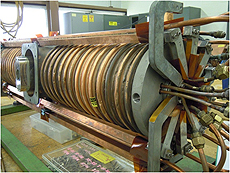Proton Improvement Plan for accelerator reliability
 |
|
Part of the Proton Improvement Plan involves refurbishing radio-frequency cavities to run at 15 hertz. Pictured here is a radio-frequency cavity tuner. Photo: Matt Slabaugh |
The Proton Improvement Plan (PIP) team is seizing the current 11-month shutdown of the Fermilab accelerator complex as its chance to initiate major upgrades to the pre-accelerator, Linac and Booster.
"The high-energy physics experiments rely upon the availability of the proton source to deliver beam," said Bill Pellico, the PIP team leader. "Without it, we cannot produce neutrinos, make muons or operate the test beam facility. We want to make sure the beam is reliable and that we can continue to operate it for the next 10 to 20 years."
Since the 1970s, the Fermilab accelerator complex has provided protons to numerous experiments. But the beamline and much of its supporting infrastructure have become outdated, inefficient or even obsolete.
"Several experiments rely on the proton beam, but the parts supporting the beamline are about 40 years old," said Bob Zwaska, the PIP deputy team leader. "We need to ensure that these parts can sustain the higher demand for beam that will come when NOvA, Mu2e and Muon g-2 become operational."
Sam Zeller, the co-spokesperson of the MicroBooNE experiment, agrees.
"The PIP is very important for the health of the Booster neutrino program," Zeller said. "Without it, the MicroBooNE physics run would take twice as long to complete."
Refurbishing the accelerator complex will require extensive upgrades that go beyond routine maintenance. One of the most pressing problems is that only one vendor in the United States still produces the parts required to replace and repair broken components in the Linac and Booster.
"At this point, it's like trying to maintain an old car." Pellico said. "The upkeep requires a lot of specialized work and it is difficult to find replacement parts when one breaks."
One of the PIP team's main goals is to ensure that the accelerator complex will remain compatible with today's technology. This goal requires refurbishing or replacing several components, including the Cockcroft-Walton in the pre-accelerator, which give the protons their initial thrust; the 30-year-old power amplifiers in the Linac; and the 40-year-old radio-frequency (RF) systems in the Booster.
"Our 19 Booster RF stations require about 22 shutdowns a year," says Pellico. "The new solid state RF station will increase the lifetime of each station from nine months to over 4 years. Sure, upgrading is a huge project, but it will ensure we will have a more reliable system in the future."
These upgrades are also necessary to increase the throughput, or the number protons per hour, that the accelerator complex can generate and sustain.
"The current throughput is not enough to satisfy the needs of NOvA," Pellico said. "We want to double the cycle rate and produce twice as many protons per hour reliably so that the experiments can operate at their full potential. But increasing the throughput will require the rest of PIP, including tasks to minimize the beam losses."
Losses are protons that are absorbed by the equipment before they make it to their final destination. These lost protons damage the equipment, increasing the deterioration rate of the beamline and accelerator downtime.
"If we raised the intensity without managing our loss rate, we would damage the equipment and likely increase worker exposure rates," Pellico said. "Making the beamline more efficient with its protons is just as important as increasing the throughput."
Even though the current economic enviroment has made these improvements seem daunting, the PIP team is preparing to do what is necessary to ensure a viable proton source until another accelerator, such as Project X, takes its place.
"We've already started on some upgrades, like those for the Booster radio-frequency amplifiers, but the rate of progress will really ramp up during the shutdown," Zwaska said. "We will be working on this full time for the next year and several years after."
—Sarah Charley
|